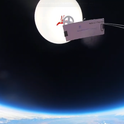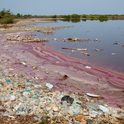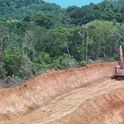In 2022, on the MVS Hidden Gem, a 228-metre-long mining vessel floating about 1,500 miles southwest of San Diego, 3,600 tons of ore-rich rocks were hauled from 2.7 miles beneath the ocean’s surface. The rocks were laden with “critical metals” such as nickel and cobalt—the kind of materials that have been used to build electric-vehicle batteries, solar panels and wind turbines. It was the first successful commercial mining test by a Vancouver startup called The Metals Company (TMC), led by CEO Gerard Barron, and a milestone in its bid to excavate the deep sea. It seemed to herald a new age of extraction.
No one has yet mined the deep sea, but in recent years exploration has ramped up in deep territorial and international waters, as prospectors have hoped to capitalise on the market for critical minerals. According to the International Energy Agency, demand for such metals will need to quadruple by 2040 if the world is to meet a net-zero emissions target by 2050.
As seabed mining in the deep sea has inched closer to reality, though, arguments over whether to allow this extractive industry to develop have become fraught. The threat of irreversible damage being done to a largely unspoiled environment led in part to 800 experts, 32 states and 57 companies favouring a ten-year moratorium on the practice. In December Norway, the nation most publicly supportive of seabed mining, announced a one-year pause on plans to mine an area of its seabed the size of the UK and Ireland. Environmentalists hailed the decision as a “historic win for nature”. And, as the types and volumes of minerals needed for the green transition have shifted, it’s no longer clear that demand for the industry is there.
The past few years have been tough for companies such as The Metals Company, which hopes to begin mining an area of the international seafloor in the Pacific as early as 2026. The firm provoked a backlash by trying to avoid regulations currently being agreed by the International Seabed Authority (ISA), a UN-affiliated agency founded in 1994 when the UN Law of the Sea (UNCLOS) came into force. For the past decade, ISA has been working on a “mining code” or industry rulebook that will eventually allow for commercial-scale extraction. Frustrated with delays, TMC threatened to begin mining even in the absence of such international laws. In May 2023, shipping company Maersk announced that it was divesting of its shares in the firm and share prices in TMC fell to an all-time low. Then in 2024, several major insurers, including Swiss Re and Hannover Re, ruled out doing business with prospective deep-sea miners. By late last year, it seemed as though the deep sea would be left untouched. “Everybody who is anybody has walked away from this [industry],” says Torsten Thiele, economist and founder of non-profit the Global Ocean Trust.
The recent election of Donald Trump, who has ambitions to free the United States of its dependence on Chinese imports, may change the story. The US—one of the world’s largest consumers of critical metals and minerals—has been on the sidelines of seabed mining, with no plans for mining its waters or international waters. The US has no claim to the international seabed, because it never ratified UNCLOS, and has no representation at ISA, which would allow it to vote on the mining code.
However, Trump’s frustration with the US’s growing reliance on China for critical minerals—which led him to talk of acquiring mineral-rich Greenland—could play into the hands of prospective miners. In December, under the Biden administration, US Congress approved a plan to study the feasibility of refining deep-sea metals on US soil. Trump’s administration has imposed tariffs on metal imports, and several ocean mining enthusiasts have been appointed to the US cabinet, including Elise Stefanik as ambassador to the United Nations. This has proved a boon to TMC, whose share price has soared almost 60 per cent since mid-January. But will Trump’s election be a game-changer for the industry?
Deep-sea minerals were first discovered by scientists aboard HMS Challenger, an oceanographic voyage that circumnavigated the globe from 1872 to 1876, sampling every ocean basin. One haul, taken southwest of the Canary Islands, contained a collection of strange black fragments. Now known as “polymetallic nodules”, these rock-like deposits were laden with manganese, cobalt, copper, nickel and other metals. They’ve since been discovered throughout the world’s oceans, as have two other types of deep-sea deposit: crusts and sulphides.
On the flanks and summits of submerged extinct volcanoes, called seamounts, scientists have found cobalt-rich crusts, packed with high-value metals including platinum and molybdenum, which are used in everything from jewellery and dentistry to electric-vehicle (EV) fuel cells, industrial alloys and as catalysts in the making of petroleum. Seafloor massive sulphides—which contain zinc, nickel, copper, gold and other rare elements—have been found near hydrothermal vents, and are formed when hot springs rise through the seafloor, causing metals to dissolve into liquid.
The first serious attempt to mine these minerals was focused on hydrothermal vents in Papua New Guinea’s Bismarck Sea. The project, Solwara 1, was the work of a Canadian company called Nautilus Minerals, which went bust in 2019. But in recent years, interest has shifted to a remote part of the Pacific Ocean called the Clarion Clipperton Zone (CCZ). Here, in international waters between Hawaii and Mexico, trillions of polymetallic nodules lie scattered across the seafloor.
The ISA has granted contractors the right to explore 1.4 million square kilometres of this international seabed, apportioning over 30 sites, which are jointly allocated to a company and a sponsoring state. For instance, TMC has acquired the rights to three of these sites, more than any other private company, with Nauru, Tonga and Kiribati its sponsoring states in the CCZ. China also holds five exploration contracts with the ISA, more than any other nation; two for polymetallic nodules within the CCZ, and three elsewhere, at sites containing nodules, sulphides and cobalt crusts. In 2025, two Chinese companies will test their nodule-mining operations in the Pacific Ocean.
Global demand for lithium, copper and cobalt was expected to spike—but projections have always been highly uncertain
In national waters, Japan and the Cook Islands have facilitated mineral exploration in their territorial seas over the past few years. Mineral exploration has also restarted at the site of Solwara 1 in Papua New Guinea. And though Norway has temporarily paused its mining plans, that could change again with a general election in September, or it could be quashed entirely if the environmental non-profit WWF wins a legal challenge against the government. Either way, it will likely be several years before any nation approves a commercial deep-sea mining operation.
The argument that deep-sea mining could be a partial solution to the climate crisis is weakening. Global demand for lithium, copper and cobalt, which miners say they can source from the deep sea, was expected to spike—but projections have always been highly uncertain, and dependent on the shifting needs of a fast-changing technology sector.
In the past two years, the outlook for cobalt, as one example, has changed markedly. Tesla, currently the world’s second largest manufacturer of EVs, now uses cobalt-free batteries in half of its fleet. BYD, the Chinese-owned industry leader, has pioneered the use of sodium-ion batteries in its EVs. If other car manufacturers follow this trend, future cobalt demand will likely drop further. “We are seeing batteries in cars, on the road, right now, that don’t rely on metals from the deep sea,” says Louisa Casson of Greenpeace. “That’s a huge shift, and it’s been really, really quick.”
Meanwhile, a surge of cheap Indonesian nickel onto the global market in the past year caused prices to crash, forcing mine closures in Australia—all of which suggests demand for the material is waning. Recent studies have shown that land-based deposits of copper are sufficient for another century, and their future demand could be reduced through recycling and innovation.
Faced with these prospects, supporters of seabed mining have backed away, while TMC is changing tack. In the past year, TMC has increased borrowing and diversified its corporate strategy, signs the firm could be under financial pressure.
Having previously stressed his company’s commitment to transitioning the world away from fossil fuels, Barron now says that metals extracted from polymetallic nodules could be used for a variety of purposes beyond green tech, including in steel—one of the sectors lumbered with tariffs under Trump’s presidency. The company is also currently seeking a $9m grant from the Pentagon to establish a US-based refinery for deep-sea metals. Ores derived from nodules could have varied defence applications, including in the creation of missiles, radar and parts for spacecraft.
Mining the abyss would disturb ocean life at an unprecedented scale, causing “irreversible damage to the ecosystems of the deep sea”, according to Martin Webeler, an ocean researcher with the Environmental Justice Foundation, a Berlin-based non-profit.
Some of the potential impacts on the CCZ are well understood. Contractors such as TMC will use 30-ton machines fitted with caterpillar tracks to suck nodules off the seafloor and send them to a surface vessel through a vertical pipe. By one estimate, a single mining machine would strip around 10,000 square kilometres of seafloor over a period of 25 to 30 years, the anticipated duration for a commercial mining contract.
It takes millions of years for polymetallic nodules to form. Each one starts out as a discarded object, such as a shark’s tooth, on the seafloor. Over time, layers of sediment, containing minerals and metals, build up around this node, at a rate of one to 10 centimetres every million years. “When you take these components out of the ecosystem, they will never come back,” says Webeler.
These potato-sized lumps may look like lifeless rocks, but they form the base of the ecosystem in the CCZ, which—at an average of 5km deep—is lightless, with near freezing temperatures and intense pressure. On the soft seafloor of this vast abyssal plain, nodules offer a rare, hard substrate; lifeforms such as sponges cling to them, and in turn offer octopuses a place to lay their eggs.
But the nodules are far more than a substrate. They are also a rare source of oxygen in the deep ocean, according to research published in July. The stunning discovery, which drew on almost a decade of research in the CCZ funded by TMC, suggests that nodules are even more crucial than once imagined, sustaining entire communities. The nodules “could be an important energy source” for deep sea life, says biologist Beth Orcutt, who is based at the Bigelow Laboratory for Ocean Sciences in Maine, and was not involved in the research. If they are mined—sucked to the surface through a destructive pipe—irreversible damage would be done.
Mining machines whip up sediment, which can resettle tens of kilometres away, smothering sedentary creatures that live on the nodules
The impact of mining would be felt far and wide. The CCZ is a quiet environment—there are few currents there, and sediment rains down at a rate of around one centimetre every thousand years. As they crawl along, mining machines whip up sediment, which can resettle tens of kilometres away, smothering sedentary creatures, such as anemones and sponges, that live on the nodules. Waste sediment, washed off the nodules and released back into the ocean, could further interfere with feeding and movement in mobile animals such as fish and jellies.
Since 2010, scientists exploring the CCZ have discovered that life there is incredibly diverse and that many species are rare. One 2023 study, from an untouched area, identified 5,000 previously unknown lifeforms. From the ping pong tree sponge, a carnivorous seafloor dweller, to the gummy squirrel, a sea cucumber that looks like a cross between a shoe and a banana, 90 per cent of the species retrieved from the CCZ in the past five years have never before been seen by anyone on Earth. It would be easy for mining to wipe out one or many species without anyone realising. While scientists have been researching the CCZ intensively in the past decade, there are still huge knowledge gaps—enough to make states, investors and insurers wary about the potential impacts on ocean health.
Even less is known about other parts of the deep ocean—for example, around 90 per cent of the area that Norway has earmarked for mining is considered unexplored. Recent expeditions have, however, revealed that Arctic seafloor is peppered with hydrothermal vents, seamounts and deep-sea sponge grounds. These are as rich in marine life as coral reefs, according to Pedro Ribeiro, deputy director at the Centre for Deep-Sea Research at the University of Bergen, whose research team has mapped part of the region.
Whether in the CCZ or elsewhere, “the science is just not advanced enough to estimate the extent of the impact that will occur,” says Webeler. Exploration, even without commercial mining, could cause unacceptable harm to areas of the deep Arctic that ought to be protected, scientists including Ribeiro say—and it will take years if not decades to complete surveys to identify those areas. “The knowledge gaps—actually there are quite a lot,” says Ribeiro. He cautions that it’s still too early to “predict what can happen with deep-sea mining, at many levels”.
At its founding, the ISA was handed a challenging, and conflicting, mandate by the UN: to facilitate deep-sea mining while also protecting the deep sea from harm. As it has struggled to finalise a mining code that meets both obligations, it has come under intense scrutiny. TMC, in collaboration with its sponsoring state Nauru, became frustrated by delays and in 2021 decided to invoke an arcane law called the “trigger” or the “two-year-rule”, which in theory would allow it (or any company) to apply to start industrial mining even without the regulations agreed.
The intention was to push the ISA’s member states to complete the regulations by 2023, and to force the ISA to consider the mining application. It might have worked: at the time the ISA’s secretary general, Michael Lodge, was something of an ally of the mining industry. Under his tenure, the ISA—which was designed to be impartial—was accused of lacking transparency, of allocating favourable claim areas to TMC, and of fast-tracking progress on the mining code to benefit industry over environmental concerns, claims that Lodge has denied. Then in August 2024, Lodge was unseated, in a scheduled leadership contest, by Brazilian oceanographer Leticia Carvalho.
Carvalho, who took over in January, is more balanced on whether mining should proceed. Her election reflects that most states want to take time developing rules about deep-sea mining. ISA member states will resume a slower pace of negotiations, which experts say will now take three or more years to conclude. “No one is saying we should adopt the regulations and allow mining to start. In fact, it’s quite the contrary,” says Pradeep Singh, an ocean governance expert at the Oceano Azul Foundation in Lisbon. Carvalho’s inaugural speech on 1st January focused on transparency, environmental protection and indigenous rights. She didn’t even use the word “mining”.
So far, TMC’s push to get started has not worked. In 2023, ISA’s decision-making council agreed, in principle, that no mining should start before the code is adopted. The council must, however, consider any mining application that comes its way, and TMC intends to submit an application in June, with a view to mining in 2026. “We would rather see the mining code in place before we started commercial production,” Barron says, before adding that “there is a risk that if you don’t get on and get these regulations completed, then you might find actors operating outside of UNCLOS… and that would be a very bad situation for the world.” For ISA, the request will be “quite a major moment”, says Casson. “If TMC do put an application in, it will force governments who are undecided to get off the fence. If you’re being asked, ‘Do you approve the world’s first application for deep-sea mining or not?’, you have to choose.”
If ISA refuses the application, TMC’s previous plan to circumvent the regulations and begin mining may prove to have been hollow. It’s unlikely that Nauru, TMC’s sponsoring state and an ISA member, would operate outside of the law, and it is improbable that a mining company, even if backed by billionaires and supported by the US president, could chart its own course to the deep.
“The US has very little influence [in this arena],” says Singh. Amid all the geopolitical rabble-rousing from the US and sabre-rattling from TMC, the “underlying facts have not changed,” says Thiele. TMC doesn’t even have a full-scale mining machine able to operate in the ocean’s abyss for years at a time. Its successful test in the Pacific involved only a prototype. “A lot of insurers won’t back the industry… and if you don’t have insurance, it’s very, very risky,” Casson warns. “Would they do it anyway? Is this the hill they want to die on? I’m not sure.”
For the time being, the ocean’s abyss remains untouched—but would-be miners are still pushing hard to get started, all too aware that the tide may be going out.












